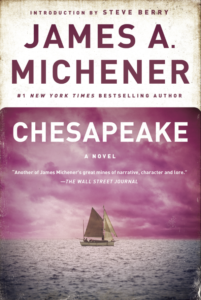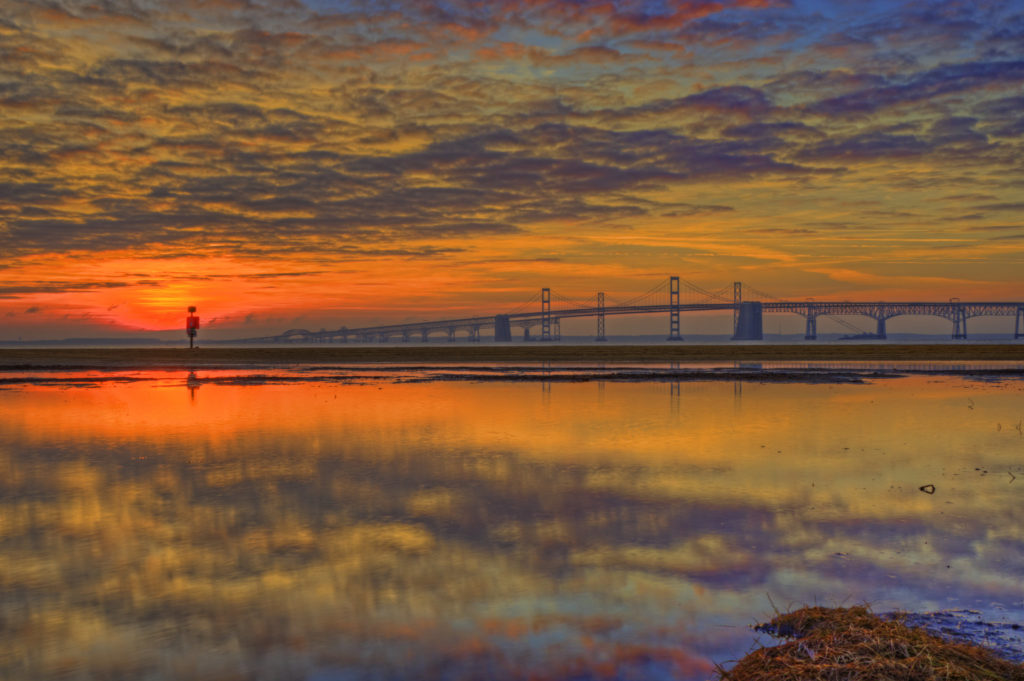Today the Chesapeake Bay represents a popular vacation destination for many Washingtonians. Others may simply recall crossing the Chesapeake as motorists on the Bay Bridge to more “exciting” destinations like Ocean City, Atlantic City, or Rehoboth Beach.
However, the Chesapeake Bay deserves greater attention. Of course, the Bay and nearby swaths of land that it influences is immense. More than 150 major rivers flow into the estuary from New York, Pennsylvania, Delaware, Maryland, Virginia, Washington D.C., and West Virginia, and it covers nearly 65,000 square miles (almost the size of Florida). Not surprisingly, the Chesapeake and its tributaries have thus served as important waterways since prehistoric times.
But in addition to its geographic importance, the Chesapeake Bay and the surrounding regions hold immense cultural, political, and religious significance for America.

Epic tome Chesapeake by author James Michener marked its fortieth anniversary since publication this year. The 865-page novel tells the story of several fictional families that lived near the Chesapeake Bay. Occurring mostly in Virginia and Maryland over the course of nearly 500 years, the saga’s characters grappled with the changing tides of in American history.
The book is divided into 14 “voyages,” cataloguing successive journeys to or within the vicinity of the Chesapeake Bay. Among the most compelling involve two Christian families from contrasting theological traditions. During the course of their fictional history, they demonstrate a theology of place in action.
Both came to America in pursuit of religious freedom. First, the Steeds were a Roman Catholic family whose patriarch who joined John Smith’s expedition to Jamestown. Steed decided to flee England quietly after several relatives were martyred by zealous Protestant monarchs. The family ultimately found haven on the isolated Eastern Shore. The family’s land eventually became part of Catholic Maryland, a colony that embraced relative toleration toward religious dissent, although the Steeds experienced ongoing tension with their neighbors in Protestant Virginia across the bay.
Another notable religious family in Chesapeake were the Paxmores. This Quaker family experienced persecution even in America. Both the founding matriarch and patriarch of the family were separately driven out of Puritan New England for proselytizing their Quaker faith.
The narrative may be fictional, but these families’ histories represent a conglomeration of the experiences faced by many early American settlers. Virginia’s history of Protestantism – particularly Anglicanism – and Maryland’s history with Catholicism are both well known. Perhaps less well known is the Quaker presence in Maryland.
The Paxmores provide significant material support to build a meeting house in the fictional town of Patamoke. The town lies along the north bank of the actual Choptank River, the largest river on the Delmarva Peninsula, which represents the southern border of Talbot County. In the middle of Talbot County is located Third Haven Meeting House, one of the oldest Quaker meeting houses in the country, dating to the mid-16th century.
George Fox, founder of Quakerism, visited the area in 1673. Fox later sent books to the Third Haven Meeting House, serving as the basis of the meeting house’s library and “the earliest public library in Talbot County.”
This real-life history surely was not lost on author James Michener. He owned a home nearby in St. Michaels, also in Talbot County, where he stayed while writing the book. Moreover, Michener was adopted by a poor Quaker couple and grew up in Pennsylvania. As an author, he lived only three hours north of St. Michaels in Doylestown, Pennsylvania, not far from a large Quaker community.
Although not a Quaker or Christian himself, Mitchner said his childhood growing up as a Quaker instilled him with character. He evidently became familiar enough with both Quaker and Catholic theology to write a penetrating discussion between members of the Paxmore family and the Steed family about their theological distinctives.
Perhaps this experience also instilled Michener with his evident deep respect for the rights of religious minorities in America like Quaker and Catholics. For example, he was quoted about his position on the rights of all Americans in the context of what was once a controversy in American society; specifically, the Catholic faith of President John F. Kennedy.
“I’ve fought to defend every civil right that has come under attack in my lifetime,” Michener said. “I’ve stood for absolute equality, and it would be ridiculous for a man like me to be against a Catholic for President.”
Religious freedom was not the only type of civil rights with which Michener grappled in Chesapeake. He also focused heavy debate over slavery, the Civil War, and race relations in the region. The abolitionist Paxmores chose to emancipate their slave and assisted in the Underground Railroad, while the plantation-owning Steeds retained their slaves and fought for the Confederacy.
Some ethical issues encountered in Chesapeake were not a matter of rights but fell more in the arena of prudential judgment. For example, the Paxmores were cautious about participating directly or tangentially in the American Revolution due to their pacifist theology; other families were less hesitant.
Towards the end of the novel, one Paxmore descendant was convicted of wrongdoing in connection with the Watergate Scandal, still relatively fresh in the minds of readers at time Chesapeake was published. This episode dealt with a Christian’s proper role in government, submission to authority, and fidelity to conscience.
This “voyage” provides an appropriate closing vignette to the novel. These events serve as a contemporary bookend to the earliest recorded human recollections in the areas of the Chesapeake Bay. It is one final example of the challenges, obstacles, and dilemmas faced by individuals in the region’s long history.
While Michener’s narrative is filled with fictional characters and invented elements, the book explores challenges that are clearly based in reality. Chesapeake ultimately deals with very real issues that Americans, especially people of faith, have been forced to consider in light of their beliefs.
As so common in American history, the novel shows how the Chesapeake Bay specifically provided a place where Americans could exercise their religious freedom and work out their faith in the context of their specific time and place. So even though it is a work of fiction, Chesapeake actually delivers something akin to a theology of place for a pivotal region in American history.
No comments yet




